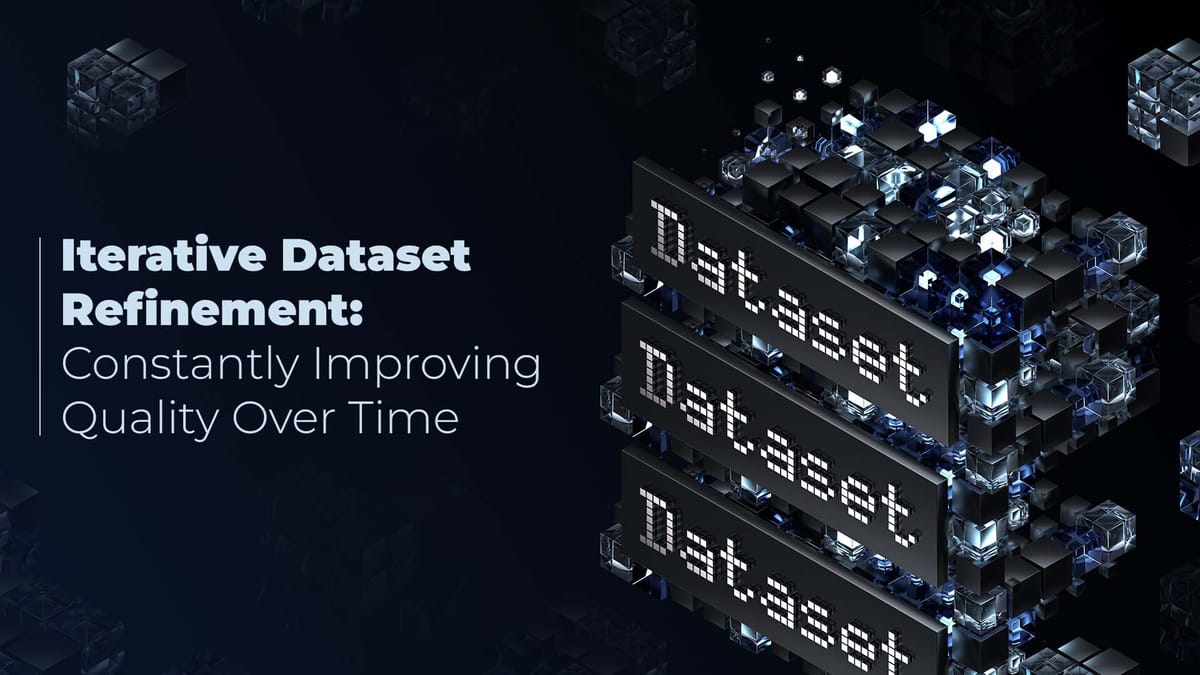Iterative Dataset Refinement: Constantly Improving Quality Over Time

In machine learning, data rarely remains unchanged. Data is constantly reviewed, errors are corrected, and refinements are added to make the models more accurate. For example, if the algorithm often confuses objects in images, experts review the markup and make adjustments. This approach allows us to gradually improve data quality and achieve better results without completely replacing the dataset.
Key Takeaways
- Experiments on diverse tasks have demonstrated the effectiveness of dataset improvement techniques.
- The process leads to higher-quality outputs through a cycle of feedback and refinement.
- Refined data iteration ensures that datasets remain accurate and valuable over time.
- This method aligns with the complex nature of modern datasets and enhances decision-making.
Definition and Importance
When working with data for machine learning, it is important to collect relevant data and constantly improve it. This means that after the first processing, the dataset is reviewed, errors are corrected, and the markup is improved. This approach helps to create more accurate models, such as analyzing financial risks or recognizing diseases in medical images. The better the data, the better the result.
How It Works
It starts with a preliminary model tested against validation datasets. Any discrepancies lead to a repeat cycle until performance metrics meet expectations. Key components include:
- Clear documentation for each iteration.
- Specific performance benchmarks.
- Systematic feedback integration.
- Tools like Python, R, sci-kit-learn, and Tableau support the process.
Key Principles
- Transparency: Each refinement stage must be clear and documented.
- Consistency: Uniformity across iterations ensures accurate enhancements.
- Alignment with Objectives: Refined data must align with organizational goals and inform decision-making.
The Lifecycle of Dataset Refinement
Improving datasets takes place in stages to make them more accurate and useful. First, data is collected, then its quality is checked, errors are corrected, and labels are updated. Each stage is critical because even minor inaccuracies can affect the results of machine learning models.
Stages of Refinement
- Assessment: This stage involves an initial examination of the dataset to determine its quality and identify areas for improvement.
- Cleansing: Using iterative data cleansing techniques, data is purified to remove inaccuracies, inconsistencies, and irrelevant information.
- Integration: During this stage, the refined data is seamlessly integrated into existing datasets, ensuring compatibility and continuity.
- Monitoring: Ongoing monitoring tracks data quality over time and identifies new issues as they arise.
Feedback Loops
Feedback allows you to improve data markup based on users' real needs. For example, if a machine learning model makes mistakes, analysts can review the annotations and make changes. This approach helps adapt data to new conditions and makes it more useful for algorithms.
Integration into Data Management
Data cleansing and improvement should be part of the overall management strategy to make working with data more efficient. This helps maintain uniform quality standards and avoid errors.
In machine learning, data goes through several stages of processing: it is collected, cleaned of unnecessary elements, and then verified.
If this process is well-organized, algorithms receive more accurate information, improving the results' quality. Feedback and step-by-step improvement help companies achieve better performance in data processing.
Enhanced Data Quality
Data quality directly affects the performance of machine learning algorithms. To maintain their accuracy, companies regularly check and clean their datasets. This includes finding errors, identifying inconsistencies, and updating outdated information. This approach helps to make data more reliable, which improves model performance and reduces the risk of errors.
Cost Efficiency
Organizations save resources by reducing manual data corrections and minimizing poor-quality data risks. Automated processes and tools for continuous enhancement lower operational costs and boost productivity.
The iterative design approach reduces usability issues early on, making it cost-effective to fix problems when it's cheaper. Techniques like A/B testing, focus groups, and user interviews help identify and solve usability problems before they grow.
Companies like Google and Microsoft have successfully applied iterative refinement. They blend continuous improvement with strategic and interaction design, creating more meaningful user experiences. This approach effectively meets user needs while keeping costs low.
Techniques for Effective Refinement
Effective refinement techniques are key to improving dataset quality in data optimization processes.
Anomaly Detection
It focuses on spotting data points that significantly differ from the norm. These could be errors, fraud, or emerging trends. Advanced algorithms are used for anomaly detection, ensuring data integrity and providing insights into areas needing closer examination or further analysis.
Feature Selection Strategies
Choosing the characteristics they analyze correctly is essential to make machine learning algorithms work faster and more accurately. Some methods allow you to eliminate unnecessary parameters, leaving only the most useful ones. For example, recursive feature elimination helps to determine which ones influence the result, and principal component analysis reduces the number of variables while retaining the primary information.
Tools and Technologies
Various tools are used for data annotation, from specialized programs to open-source solutions and cloud platforms. Some allow you to quickly mark up large amounts of information, while others help improve accuracy through automation.
For example, in machine learning, services for labeling images or texts are popular. These services simplify annotators' work and reduce errors.
Open-Source Alternatives
Apache Spark and TensorFlow Data Validation are often used to work with data. They give more freedom to customize processes and do not require the purchase of commercial licenses. Such solutions suit teams that want to customize the markup to their tasks and work more efficiently with large amounts of data in machine learning.
Cloud-Based Platforms
Google Cloud, AWS, and IBM Cloud allow companies to scale their resources and access powerful computing capabilities quickly. These platforms will enable you to work with large amounts of data efficiently, applying advanced methods to improve it, which helps maintain information's accuracy and relevance.
The cloud also allows for continuous data improvement, which is essential for machine learning, as models must be updated regularly. Using such tools helps organizations maintain data accuracy and ensure continuous improvement.
Data Volume and Complexity
The sheer volume and complexity of data can pose serious challenges. For example, Google Dataset Search contains 45 million datasets from more than 13,000 sources, making it difficult to manage them effectively. Each dataset has its own unique structure, which requires the use of special tools and methods for processing and analyzing it.
Maintaining Consistency
In machine learning, maintaining data consistency across multiple sources and updates can be challenging. With the proliferation of open data, millions of datasets are available on thousands of sites. To ensure that data remains accurate and consistent, you must constantly check it and improve strategies for working with it.
Metrics for Measuring Quality
These metrics are vital for continuous data enhancement and iterative data cleansing. They help maintain and improve data quality over time.
Key Performance Indicators
- Accuracy: Measures the correctness of data entries.
- Timeliness: Ensures data is up-to-date and available when needed.
- Completeness: Checks if all required data is present.
- Consistency: Ensures data uniformity across various datasets.
- Validity: Confirms that data values are within acceptable ranges.
Benchmarking Techniques
Benchmarking is the comparison of data with generally accepted standards or good practices. This approach helps to find problems in data processing. One method is to compare data with industry norms to identify discrepancies. Another method is to observe changes in data quality over time to identify trends. It is also common to set goals for data improvement based on industry best practices.
Continuous Monitoring
It involves real-time oversight of data pipelines and workflows. This enables proactive detection and correction of issues. Key elements include:
- Real-Time Monitoring: Ensures immediate identification of data quality issues.
- Alerting Systems: Notifies stakeholders about data inconsistencies or anomalies.
- Root Cause Analysis: Helps identify the underlying causes of data quality problems, facilitating timely remediation.
Real-World Applications
In finance, healthcare, and retail industries, continuous data improvement is essential. For example, in machine learning, the data set is constantly tested and adjusted to achieve better results. More accurate data helps make more informed decisions, affecting business efficiency and reducing risks.
Engaging Stakeholders
Involving people from different departments at every stage is essential to keeping a project on track. This allows you to get a variety of perspectives and ensure that everyone is on board. For example, in areas such as healthcare or fraud detection, the accuracy of data markup directly impacts the final results.
To collaborate effectively, you can:
- Regular reports and clear communication,
- Training and workshops,
- Collecting and acting on feedback.
Future Trends in Dataset Refinement
New technologies and methods are changing the process of improving datasets over time. In the future, we expect to see an increase in the use of automation for processing large amounts of data, making this process faster and more accurate. Tools that reduce the impact of human error and increase annotation efficiency for training machine learning models will play an important role.
The Rise of DataOps
DataOps is becoming an essential tool for effective data management, especially in the context of the rapid development of machine learning. This approach allows organizations to maintain high data quality and work with large, complex data sets without loss. With DataOps, you can set up data processing processes faster and ensure stability even in complex projects.
Ethical Considerations
The use of advanced technologies for data processing requires attention to ethical issues. This includes principles such as fairness, transparency, and responsibility. For example, when developing machine learning models, it is essential to properly manage sensitive data and ensure openness in the decision-making process. Organizations should consider these principles to create reliable and legitimate data strategies, particularly in automation and AI integration.
Collaborative Approaches to Refinement
Collaboration between specialists helps significantly improve processes, particularly in machine learning. By sharing knowledge and experience, data can be used more efficiently, which leads to better results.
Open Data Initiatives
Open initiatives are changing the way data is managed. When companies share data sets, they create new ideas and collaboration opportunities. This allows for greater access to a variety of data, which is essential for training artificial intelligence models. With larger data sets, it becomes possible to train and validate models more accurately, which affects their performance and ability to make more accurate predictions.
Summary
This method involves continuous data improvement by breaking the process into cycles. At each stage, feedback is collected, allowing for gradual improvement of the results. This is an essential approach in machine learning, where models need regular adjustments to adapt to new requirements. Each step helps to ensure consistent data quality, which allows for better results in the long run.
FAQ
What is iterative dataset refinement?
Iterative dataset refinement is a continuous improvement process in which each stage of working with data produces new results that are used for further improvements. For example, in machine learning, a model receives new data and adjusts its predictions, gradually becoming more accurate.
How does iterative dataset refinement work?
This process is repeated to continuously improve data quality. It includes data cleansing, validation, and enrichment to keep datasets relevant and valuable.
Why is iterative dataset refinement necessary?
Data refinement through several stages is necessary in cases where accuracy is essential, such as in machine learning for prediction or recognition. The better the data is, the more reliable and accurate its results will be. This is especially important in finance or healthcare, where even minor errors can have serious consequences.
What are the key principles of iterative dataset refinement?
Key principles include transparency, consistency, and alignment with organizational objectives. These ensure refined data drives valuable insights and maintains quality standards.
What are the stages of dataset refinement?
The lifecycle includes assessment, cleansing, integration, and monitoring. Feedback loops are critical, allowing continuous improvements based on operational results and new data integration.
How are feedback loops used in the refinement process?
Feedback loops enhance data quality by incorporating operational results and new data. This iterative approach ensures data quality is continually improved.
How is iterative dataset refinement integrated into a broader data management strategy?
Practical refinement is integrated into the broader data management strategy. This ensures consistency across all data assets and adherence to governance standards.
What are the benefits of iterative dataset refinement?
Benefits include enhanced data quality, improved decision-making, and cost efficiency. High-quality data optimizes operations and reduces manual corrections.
What techniques are used for practical dataset refinement?
Techniques include advanced data cleansing, anomaly detection, and feature selection. These methods remove inaccuracies, identify critical errors, and focus on relevant features.
What tools and technologies are used for dataset refinement?
Popular tools include data management and analytics platforms with robust cleansing capabilities. Open-source alternatives offer flexibility, while cloud-based platforms provide scalability and advanced computation resources.
What challenges are faced in iterative dataset refinement?
Challenges include managing data volume and complexity, maintaining consistency, and balancing resource allocation. These challenges require careful management and prioritization.
How is the quality of refined datasets measured?
Quality is measured using KPIs like accuracy, timeliness, and completeness. Benchmarking techniques compare datasets against industry standards, ensuring continuous data quality monitoring.
What are the real-world applications of iterative dataset refinement?
Applications are seen in finance, healthcare, and retail, where data-driven decisions are critical. In machine learning, refined data enhances model accuracy, leading to optimized operations and increased profitability.
What are the best practices for implementing dataset refinement?
Best practices include establishing a robust framework, engaging stakeholders, and continuous learning. This ensures the organization remains responsive to changes in data and technology.
What future trends are expected in dataset refinement?
In the future, automation and integration of artificial intelligence are expected to increase, significantly speeding up data processing. A new approach called DataOps, similar to DevOps, is emerging, allowing for rapid data management and integration into various systems. There is also growing attention to ethical issues such as fairness and transparency, which is becoming an essential aspect in developing machine learning technologies.
How do collaborative approaches benefit dataset refinement?
Collaborative approaches involve cross-functional teams bringing diverse perspectives and expertise. Open data initiatives and community contributions support innovation and improvement in dataset refinement.



Comments ()